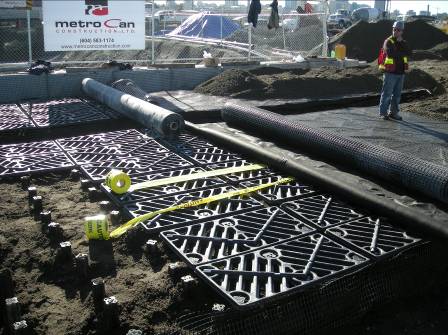
The Silva Cell product is designed for use in the urban environment, so integrating Silva Cells and underground utilities is an important topic to us. In a previous post we discussed basic design strategies and construction methods for integrating Silva Cells and utilities. The next question we’re most often asked usually starts something like this: “So what happens when down the road some contractor shows up with an excavator and starts tearing out Silva Cells because they don’t know they are there?”
To help provide answers, I put together a few thoughts on protecting Silva Cells and nearby utilities from accidental damage.
1. Insist on as-built drawings
Logically, the greatest challenge in protecting Silva Cells from accidental damage is making sure that contractors and others know that they are there in the first place. Perhaps the most important tool for this is the old tried and true “as built drawing.” I know it seems like a no-brainer, but it is imperative that everyone involved in the project — designers, owners, municipal staff, and so on — recognize the need for the location of the Silva Cells to be accurately recorded at the time of installation and also to identify who will be accountable for doing so.
2. Register with the local One-Call center
Another effective tool is registering Silva Cell systems with the local One-Call underground utility location centers. For those not familiar with them, One-Call Centers are regionally-operated call centers that provide contractors and other professional doing underground work a single point of contact for arranging to have the underground utilities in a given area located. Once a utility is registered with the local One-Call service, contractors requesting utility locates in the vicinity of the Silva Cell systems will be made aware of the presence of the Silva Cells. At this time I’m not aware of any North American Silva Cell installations that have been registered with a One-Call service, but I know it has been a topic of much discussion.
(In the United Kingdom, by contrast Silva Cells fall under the category of “engineering structures,” which includes stormwater crates, holding tanks, etc., and therefore it’s quite common for them to be registered with the local One-Call centers.)
3. Create a visual marker
A third option for avoiding future damage to Cell systems is to provide some type of visual indicator above the Silva Cells while they are being constructed. Visual indicators can range from plastic utility warning ribbon (as seen below) to using orange colored geotextile fabric over the Silva Cells.

4. Be able to accurately locate Silva Cell systems and any utilities running through them in the field.
Ensuring that contractors and other underground workers will be alerted to the presence of Silva Cells in an area is only half of the battle. The other half of the battle is to be able to accurately locate the Silva Cells in the field and to locate any utility lines running through them.
Properly and accurately dimensioned as-built drawings again play a vital role in being able to physically locate Silva Cell systems after they’ve been installed. Utility locating equipment can also be very effective for physically locating Silva Cell systems and/or utility lines running through them. Because Silva Cells are constructed from a high grade polypropylene plastic, they create little or no distortion of the various signals. Utility locating equipment which utilizes ground-penetrating radar is capable of distinguishing the outline of Silva Cells in the ground as well as any utility lines running through the system.

More standard utility locating equipment such as Metrotechs and others which read an electronic signal that is emitted from a base station and sent along the path of the utility line can also be used effectively provided that a locate or trace wire is installed along with the Silva Cells (something that is relatively easy and inexpensive to do). This can be done by wrapping a #14 AWG Copper Clad insulated wire around the perimeter of the Silva Cell system as its being installed and leaving the ends of the wire accessible in either a port in the pavement or in a tree opening.
These are a few of the things I’ve learned over the course of the many (many!) installations I’ve observed. If you have any additional ideas from your own experience, I would love to hear them.






This utility installation is a big deal and needs to be treated seriously. There is so much preparation to do before it actually happens. But it is worth it! It’s good that companies keep their design basics though so it can be adapted and applied to any circumstance.